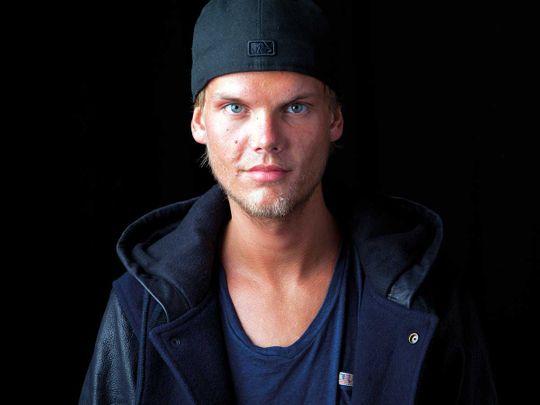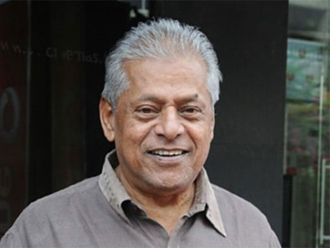
At the top of the Bird Streets in West Hollywood, in front of a Modernist mansion with gobsmacking views of the Sunset Strip, Salem Al Fakir stepped out of his car and felt the loss all over again.
The Swedish producer and songwriter, 37, hadn’t been to this house, sheathed in blue glass and immaculate green hedges, in over a year. Not since he got the news of what happened last April to his friend Tim Bergling, the dance music artist known as Avicii.
Bergling lived and worked here until his suicide in Oman last spring at age 28. Al Fakir wrote and recorded with Bergling in this house. New owners had since moved in, but the memories of last year’s grieving welled up as soon as he saw it.
“I might need to take a step back,” Al Fakir said. “It’s a bit too much.”
Other friends and collaborators of Avicii’s pulled up: Al Fakir’s production partner Vincent Pontare; singers Aloe Blacc and Joe Janiak; Neil Jacobson, the president of Geffen Records, Avicii’s label. Jacobson hugged Blacc as he got out of his own car.
They’d gathered here to start talking about ‘Tim’, a posthumous album from Bergling, the star Swedish DJ, songwriter and musician, finished by these collaborators based on his production notes. The album, released this week, captures some of the last ideas from a young superstar producer, expanding on his gifts for melody and genre twists.

BOUNDARY PUSHER
Bergling’s death was, in some ways, a valediction for the uplifting, industry-shaking EDM scene of the 2010s. With his breakout single “Le7els” in 2011, Avicii helped define an era of mega-festivals like Electric Daisy Carnival, when DJs suddenly commanded mid-six-figures for gigs. He was parodied by Andy Samberg as DJ Davvinci on “SNL” (Bergling reportedly loved the skit). But even in that heady era, Bergling stood out as a restless songwriter who pushed the boundaries EDM placed around him. One of his biggest hits came in 2013 with the folk-tinged “Wake Me Up,” with soul singer Blacc on lead vocals.
Bergling was candid about his problems with heavy drinking and mental health. In 2016 he retired from his relentless touring to focus on recovery and studio work. “The next stage will be all about my love of making music to you guys. It is the beginning of something new,” he wrote in a statement at the time. A documentary, “Avicii: True Stories,” came out on Swedish Netflix just days after his death and captured a deeply troubled star nearly broken by the stress of fame. But Bergling had approved of its candour, and he seemed to be rounding a bend in his recovery. His suicide cut all that reinvention short.
The news devastated the dance and pop music communities, along with his family (he was survived by his parents and three siblings). While Bergling’s struggles were well-known, those who knew him personally didn’t expect anything like what happened.
“My conversations with Tim?” Jacobson recounted. “‘Hey buddy, what’s going on?’ ‘I’m doing great.’ ‘What are you working on? Let’s schedule a time next week for other sessions.’ ‘Oh, I can’t do it next week, I’m going to Oman.’ ‘What’s in Oman?’ ‘I don’t know man, I hear it’s beautiful.’”
Bergling sounded “jovial, happy,” Jacobson said. “I had no idea.”
After the funeral in Sweden, his closest collaborators were left with more than grief. They now had to decide what to do with the music.
With the blessing of Bergling’s parents, his management and label began sorting through his hard drives and Dropbox accounts.
“After Tim passed away, Tim’s father asked me, ‘Can you please go through Tim’s devices and see if you find any clues about the music?’” said Christopher Thordson, who managed Avicii after Bergling retired from touring. “What happened, obviously, it’s so sad and tragic. I couldn’t listen to his demos for a couple of days after his passing. You’d just burst into tears listening to it. It’s been a lot of sleepless nights.”
Based on those notes and about 200 demos, a picture began to emerge for a coherent album. Some of Bergling’s ideas came as total surprises to his eventual collaborators.
TOWARD A NEW SOUND

‘Tim’, the album gleaned from these sessions, showcases Avicii’s wide ambitions and pop songwriting prowess beyond EDM.
Some singles like Janiak’s ‘Bad Reputation’ have a heavy, humid dancehall lilt; ‘Heart Upon My Sleeve’ returns to folk with alt-rockers Imagine Dragons taking lead on the vocals. Al Fakir and Pontare’s production team, Vargas & Lagola, helm some unexpected Indian string flourishes on ‘Tough Love’ and eerie trip-hop on ‘Excuse Me Mr Sir’.
It would have been a major reset of Avicii’s sound, one that could have cemented him in the upper tier of contemporary pop producers. EDM’s high-energy, four-on-the-floor beat has fallen out of fashion in pop, and this album would have fully left it behind.
But it’s also hard not to hear a dark undercurrent in many of the lyrics. “Can you hear me? S.O.S. / Help me put my mind to rest / Two times clean, I’m acting low / a pound of weed and a bag of blow,” Blacc sings on ‘SOS’. On ‘Bad Reputation’, Janiak channels the anxiety around Bergling’s public perception as a hard-partying embodiment of EDM decadence.
Those songs, though dark and self-critical, were written at a moment of relative peace for Bergling, at least as his collaborators saw them.
For fans, the range on ‘Tim’ will remind them of the talent and expansive vision underneath Avicii’s EDM ascent. For the industry, it’s also a stark reminder of the human costs and pain behind the jet-set Instagrams that drive this new era of hyper-visible life as an artist.
And for those who combed his Dropbox files and did their best to finish what Bergling started, it’s a sense of closure. One last session in that house in the Bird Streets.













